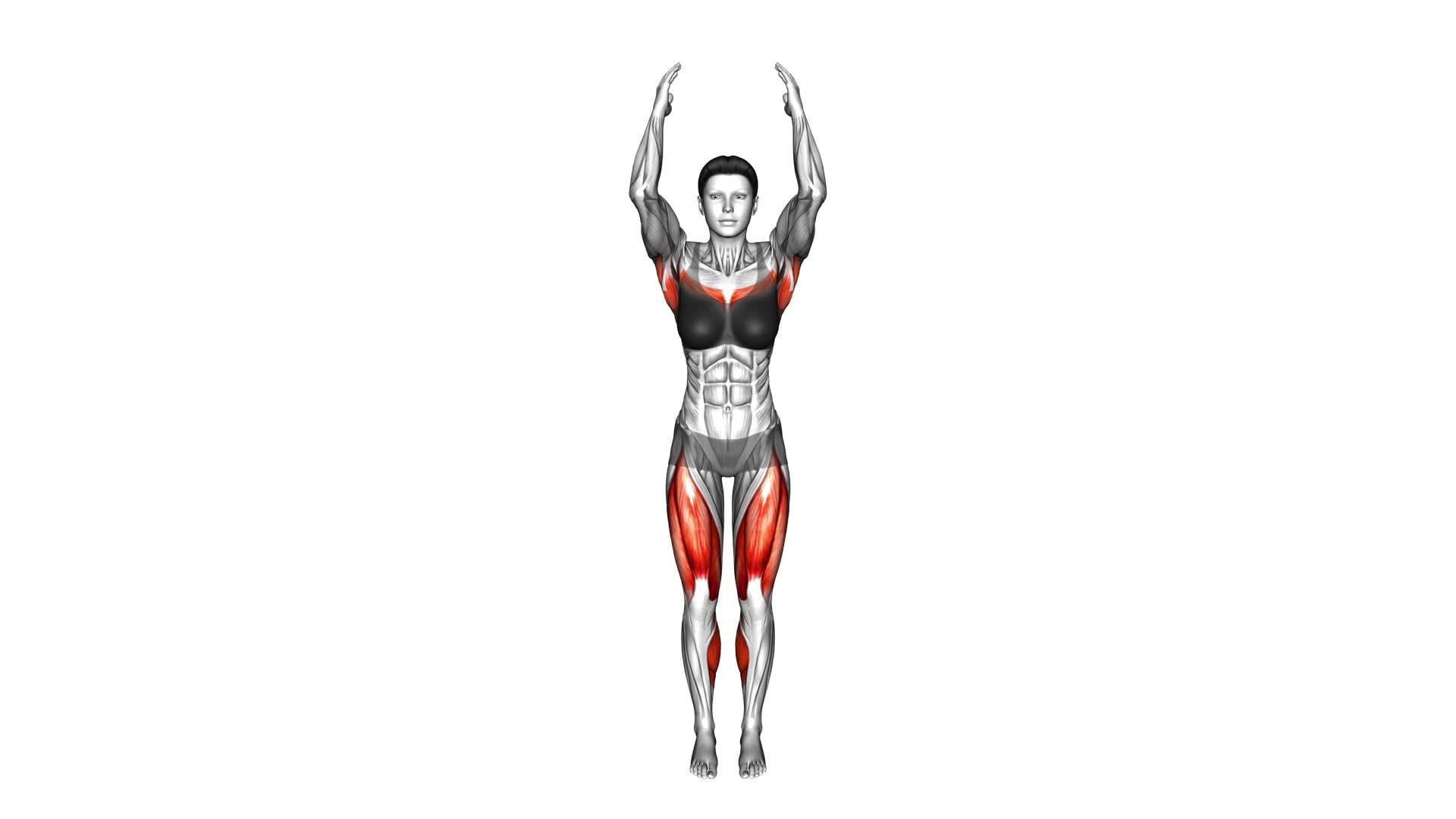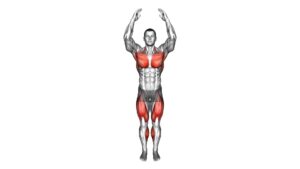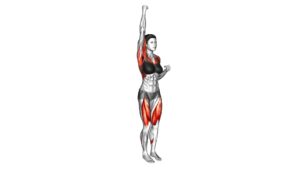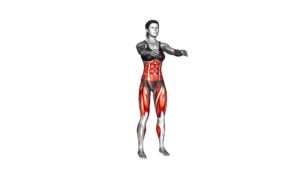Standing March With Shoulders Extension (Female) – Video Exercise Guide & Tips

Are you looking for a new exercise to target your shoulders and improve your posture? Look no further than the Standing March with Shoulders Extension!
Watch This Exercise Video
This video exercise guide and tips article will walk you through the proper form and technique for females. Whether you're a beginner or a seasoned fitness enthusiast, we've got modifications and variations to suit your fitness level.
Don't make common mistakes, follow our expert tips and seamlessly incorporate this exercise into your fitness routine.
Key Takeaways
- Improved shoulder mobility
- Increased core strength
- Improved posture and alignment
- Targets upper back, shoulders, and chest muscles
Benefits of the Standing March With Shoulders Extension
You will experience improved shoulder mobility with the Standing March With Shoulders Extension exercise. This exercise is highly effective in increasing core strength and improving posture. By performing this exercise regularly, you'll notice significant improvements in your overall shoulder mobility.
One of the key benefits of the Standing March With Shoulders Extension is increased core strength. As you raise your arms and extend your shoulders, you engage your core muscles to maintain stability and balance. This helps to strengthen your abdominal muscles, lower back, and hips, leading to a stronger and more stable core.
In addition to increased core strength, this exercise also helps to improve posture. By standing tall and extending your shoulders, you actively work to correct any imbalances or slouching in your upper body. This exercise targets the muscles in your upper back, shoulders, and chest, helping to strengthen and lengthen them. As a result, you'll notice an improvement in your overall posture and alignment.
Proper Form and Technique for Females
To properly execute the Standing March With Shoulders Extension exercise as a female, focus on maintaining a tall posture while actively extending your shoulders. This exercise is a great addition to your female fitness routine, as it targets the shoulder muscles, helping to improve strength and posture.
To begin, stand with your feet shoulder-width apart and your arms at your sides. Engage your core and keep your back straight throughout the exercise. Lift your right knee towards your chest, while simultaneously extending your left arm straight out in front of you. As you lower your right knee, bring your left arm back to your side. Repeat this movement on the opposite side, lifting your left knee and extending your right arm.
Keep the movements controlled and avoid swinging your arms or lifting your knees too high. Focus on activating your shoulder muscles as you extend your arms and maintain a steady pace. Aim for 3 sets of 10-12 repetitions on each side.
Remember to breathe evenly throughout the exercise and listen to your body. If you experience any pain or discomfort, stop and consult a fitness professional.
Incorporating the Standing March With Shoulders Extension into your shoulder exercises will help strengthen your upper body and improve your overall female fitness.
Modifications and Variations for Different Fitness Levels
For different fitness levels, modifications and variations can be made to the Standing March With Shoulders Extension exercise discussed in the previous subtopic. Here are four options to adapt the exercise based on your fitness level:
- Adaptations for beginners:
- Start with a lower step height or no step at all.
- Perform the exercise without weights or with lighter weights.
- Reduce the range of motion by lifting your knees lower and extending your arms less.
- Advanced modifications for experienced individuals:
- Increase the step height to challenge your leg strength and balance.
- Use heavier weights or resistance bands to intensify the shoulder extension movement.
- Incorporate a knee drive at the top of the march to engage your core and hip flexors.
- Add a hop or jump between each march to elevate the cardio aspect of the exercise.
Remember, it's important to listen to your body and progress at a pace that feels appropriate for your fitness level. Always consult with a fitness professional if you have any concerns or specific limitations.
Common Mistakes to Avoid During the Exercise
Avoiding common mistakes is crucial when performing the Standing March With Shoulders Extension exercise. To ensure you're getting the most out of this exercise and avoiding any potential injuries, it's essential to maintain proper form throughout.
One common mistake to watch out for is arching your lower back excessively. This can put unnecessary strain on your spine and may lead to back pain. Instead, focus on engaging your core muscles and keeping your spine in a neutral position.
Another mistake to avoid is allowing your shoulders to hunch forward during the exercise. This can lead to poor posture and shoulder discomfort. Remember to keep your shoulders pulled back and down, maintaining a tall and upright posture.
Lastly, be mindful of the speed and control of your leg movements. Avoid swinging your legs or rushing through the exercise. Instead, focus on lifting your legs with control and maintaining a steady pace.
Tips for Incorporating the Standing March Into Your Fitness Routine
To incorporate the Standing March into your fitness routine, focus on maintaining proper form and engaging the core muscles, which will maximize the effectiveness of the exercise. Here are some tips to help you incorporate this exercise seamlessly into your routine:
- Start with a warm-up: Before beginning the Standing March, make sure to warm up your body with some light cardio exercises. This will increase your heart rate and prepare your muscles for the workout.
- Pay attention to your breathing: Incorporating cardio into your routine requires proper breathing techniques. Breathe in through your nose and exhale through your mouth as you perform the exercise. This will help oxygenate your muscles and improve your endurance.
- Add variations: Once you have mastered the basic Standing March, try incorporating variations to challenge your body further. You can add resistance bands or ankle weights to increase the intensity of the exercise.
- Include it in circuit training: To make the most out of your workout, include the Standing March in a circuit training routine. This will help you burn more calories and improve your overall fitness level.
Frequently Asked Questions
How Many Calories Does the Standing March With Shoulders Extension Burn?
When you do the standing march with shoulders extension exercise, you can burn calories and reap several benefits.
This exercise engages your lower body muscles, including your glutes, quads, and hamstrings, while also targeting your shoulders and upper back.
By incorporating this exercise into your routine, you can improve your cardiovascular fitness, enhance your overall strength, and burn calories to support weight loss or maintenance.
Can Men Also Perform the Standing March With Shoulders Extension Exercise?
Yes, men can also perform the standing march with shoulders extension exercise. It isn't limited to just females.
This exercise is great for men's fitness as it targets the shoulders and helps improve upper body strength and stability. Shoulder exercises like this can also benefit men by improving posture, reducing the risk of shoulder injuries, and enhancing overall athletic performance.
Incorporating this exercise into your routine can be a beneficial addition to your fitness regimen.
Is It Necessary to Warm up Before Doing the Standing March With Shoulders Extension?
Before you perform the standing march with shoulders extension exercise, it's important to warm up. Warm up exercises help prepare your muscles and joints for physical activity, reducing the risk of injury.
They also increase blood flow and oxygen to the muscles, improving their performance during the exercise.
Can the Standing March With Shoulders Extension Help Improve Posture?
The standing march with shoulders extension is an exercise that can help improve your posture. By engaging your core and extending your shoulders back, this exercise promotes correct alignment of your spine and shoulders.
The standing march also works your leg muscles, providing additional benefits. Incorporating this exercise into your routine can lead to better posture and overall body alignment.
How Often Should the Standing March With Shoulders Extension Be Performed in a Fitness Routine?
To get the most out of your fitness routine, it's important to know how often to perform the standing march with shoulders extension. Incorporating this exercise into your cardio workout can have great benefits for improving posture.
Beginners can modify the movement by starting with smaller steps and gradually increasing the range of motion. Aim to perform this exercise 2-3 times per week to see optimal results.
Remember to listen to your body and adjust accordingly.
Keep up the good work!
Conclusion
Incorporating the standing march with shoulders extension into your fitness routine can offer several benefits for females.
This exercise helps improve shoulder strength and flexibility while engaging the core and lower body muscles.
By maintaining proper form and technique, you can maximize the effectiveness of this exercise.
Remember to avoid common mistakes and consider modifications or variations to suit your fitness level.
Add the standing march to your routine for a well-rounded workout.

Author
Years ago, the spark of my life’s passion ignited in my mind the moment I stepped into the local gym for the first time. The inaugural bead of perspiration, the initial endeavor, the very first surge of endorphins, and a sense of pride that washed over me post-workout marked the beginning of my deep-seated interest in strength sports, fitness, and sports nutrition. This very curiosity blossomed rapidly into a profound fascination, propelling me to earn a Master’s degree in Physical Education from the Academy of Physical Education in Krakow, followed by a Sports Manager diploma from the Jagiellonian University. My journey of growth led me to gain more specialized qualifications, such as being a certified personal trainer with a focus on sports dietetics, a lifeguard, and an instructor for wellness and corrective gymnastics. Theoretical knowledge paired seamlessly with practical experience, reinforcing my belief that the transformation of individuals under my guidance was also a reflection of my personal growth. This belief holds true even today. Each day, I strive to push the boundaries and explore new realms. These realms gently elevate me to greater heights. The unique combination of passion for my field and the continuous quest for growth fuels my drive to break new ground.







